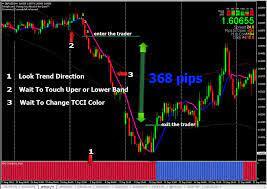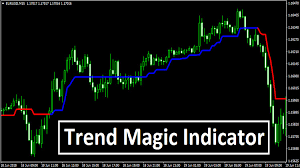Introduction

The foreign exchange market, also known as the forex market, is the largest financial market in the world, with an average daily trading volume of over $5 trillion. Due to its size and liquidity, the forex market offers numerous opportunities for traders to make profits. However, navigating the market can be challenging, particularly for new traders, as it is heavily influenced by various economic and political factors that can lead to significant price swings. Forex trend indicators can help traders understand the market direction, making it easier for them to make informed trading decisions.
Types of Forex Trend Indicators
There are several types of forex trend indicators, each with its own unique approach to identifying trend direction. The most common types include:
- Moving Averages
- Bollinger Bands
- MACD (Moving Average Convergence Divergence)
- Parabolic SAR
- Trendline
Moving Averages
Moving averages are the most basic and widely used forex trend indicator. They are calculated by averaging the price of an asset over a set number of periods, creating a smooth line that follows the price action. Moving averages are used to identify the direction of the trend by looking for a slope in the average. If the moving average is sloping upwards, it indicates an uptrend, while a downward slope indicates a downtrend.
Bollinger Bands
Bollinger Bands are a volatility indicator that use moving averages to define upper and lower limits for price action. The upper band represents overbought levels, while the lower band represents oversold levels. When prices touch the upper band, traders may look to sell, while prices touching the lower band may indicate a buying opportunity.
MACD (Moving Average Convergence Divergence)
MACD is a momentum indicator that uses two moving averages to indicate trend direction. The MACD line is calculated by subtracting a 26-day exponential moving average from a 12-day exponential moving average. A 9-day moving average (signal line) is then plotted on top of the MACD line to signal potential trades. When the MACD line crosses above the signal line, it is a bullish signal, indicating that an uptrend may be underway. Conversely, a bearish signal is given when the MACD line crosses below the signal line.
Parabolic SAR
The Parabolic SAR (Stop and Reverse) indicator is used to identify trend direction and potential reversal points. The indicator plots dots above or below prices, with the placement of the dots indicating trend direction. If the dots are below prices, it signals an uptrend, while dots above prices signal a downtrend. When the dots switch placement, it indicates a potential reversal in trend.
Trendline
Trendlines are a simple and effective tool for identifying trend direction. A trendline is created by connecting two or more price points and is used to identify support and resistance levels. If prices are consistently finding support at a certain level, it is considered an uptrend, while consistently hitting resistance signals a downtrend.
How to Use Forex Trend Indicators
Using Forex Trend Indicators
Forex trend indicators can be used in a variety of ways to inform trading decisions. Some traders may choose to use a single indicator, while others may use a combination of indicators for a more comprehensive analysis. Here are a few strategies for using forex trend indicators:
- Trend Confirmation: Using multiple indicators to confirm the direction of a trend can help traders make more informed decisions. For example, if a moving average and Bollinger Bands are both indicating an uptrend, it provides stronger confirmation for a trader to enter a long position.
- Trend Reversal: Indicators such as Parabolic SAR can be useful in identifying potential trend reversals. If an uptrend is indicated by one indicator and a potential reversal is signaled by another, traders may choose to exit their long positions and enter short positions.
- Trend Strength: Some indicators, such as the MACD, also provide insight into the strength of a trend. A strong trend is indicated when the MACD line is far from the signal line, while a weak trend is indicated when the two lines are close together. This information can be useful for traders to determine their position size and risk management strategy.

How to Incorporate Forex Trend Indicators into Your Trading Strategy
- Choose the Right Indicators There is a wide range of forex trend indicators available, each with its own strengths and weaknesses. Traders should carefully consider their trading style and goals before choosing which indicators to use. It is also important to use multiple indicators for a comprehensive analysis.
- Set Up Indicators Correctly Once the right indicators have been chosen, traders should set them up correctly. This includes choosing the appropriate settings and parameters for each indicator to ensure the best results.
- Practice Using Indicators Practice makes perfect and the same goes for using forex trend indicators. Traders should practice using their indicators on a demo account before applying them to live trades. This will help traders become familiar with how the indicators work and how to effectively incorporate them into their trading strategy.
The Benefits of Forex Trend Indicators
- Improved Timing Forex trend indicators can help traders make more informed decisions about when to enter or exit a trade. By providing signals about the direction of the trend, traders can enter trades at the right time, increasing the chances of success.
- Increased Confidence Forex trend indicators can help traders feel more confident in their trades by providing a second opinion on market movements. Incorporating multiple indicators can further increase confidence and help traders make better decisions.
- Risk Management Forex trend indicators can also help traders with risk management. By providing signals about trend strength and potential trend reversals, traders can adjust their position size and stop-loss orders accordingly.
- Trend Identification Forex trend indicators can quickly identify the direction of the trend, saving traders valuable time and energy in analyzing the market. This information can be used to make informed trading decisions and increase profits.
Conclusion
Forex trend indicators can play a crucial role in a trader’s success in the forex market. By helping traders understand the direction of the market trend, forex trend indicators can improve trading decisions and potentially increase profits. However, it is important to note that forex trend indicators should not be relied upon exclusively, as they are only one part of a comprehensive trading strategy. Traders should also consider other factors, such as economic data releases and political events, when making trading decisions.